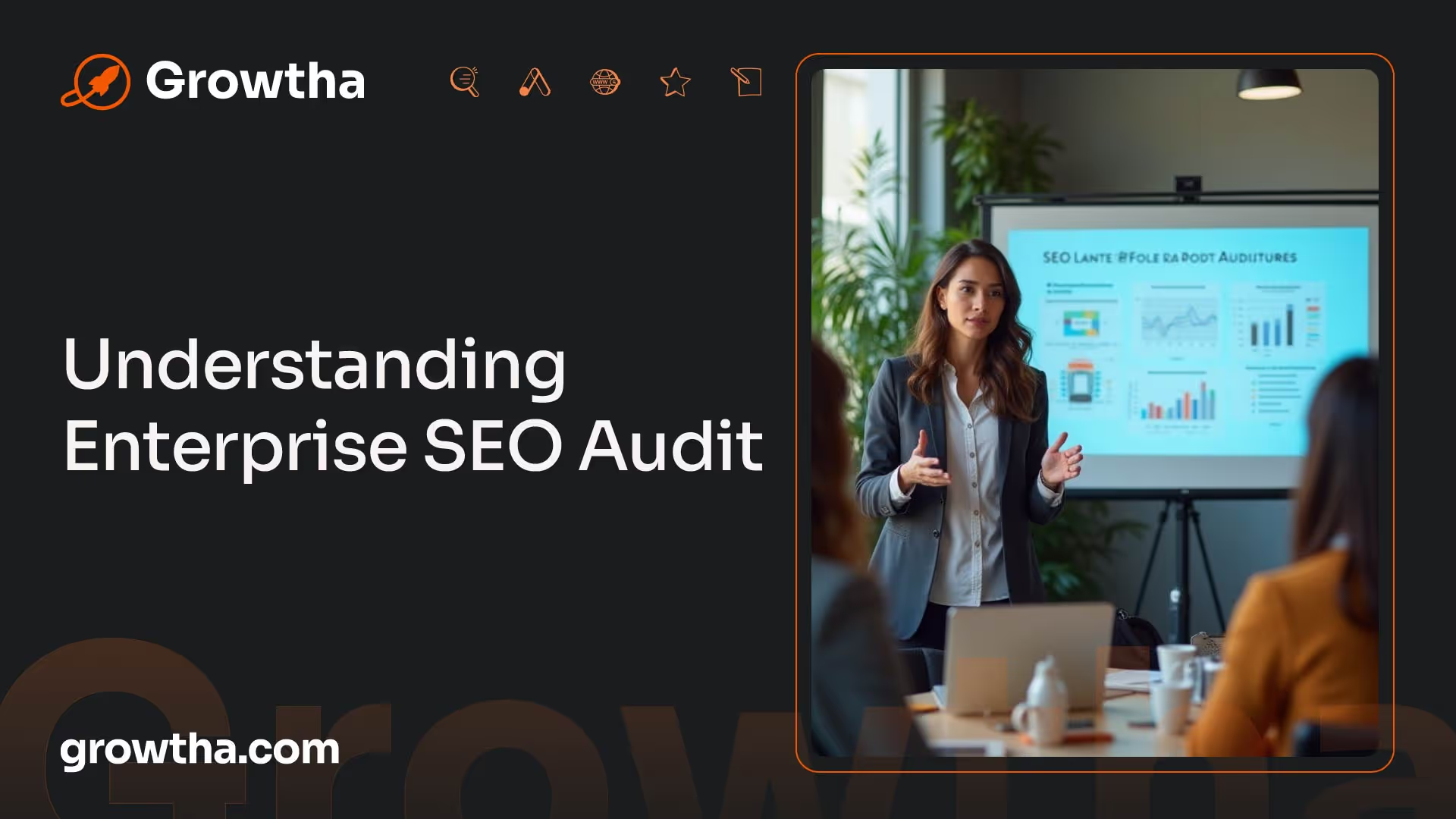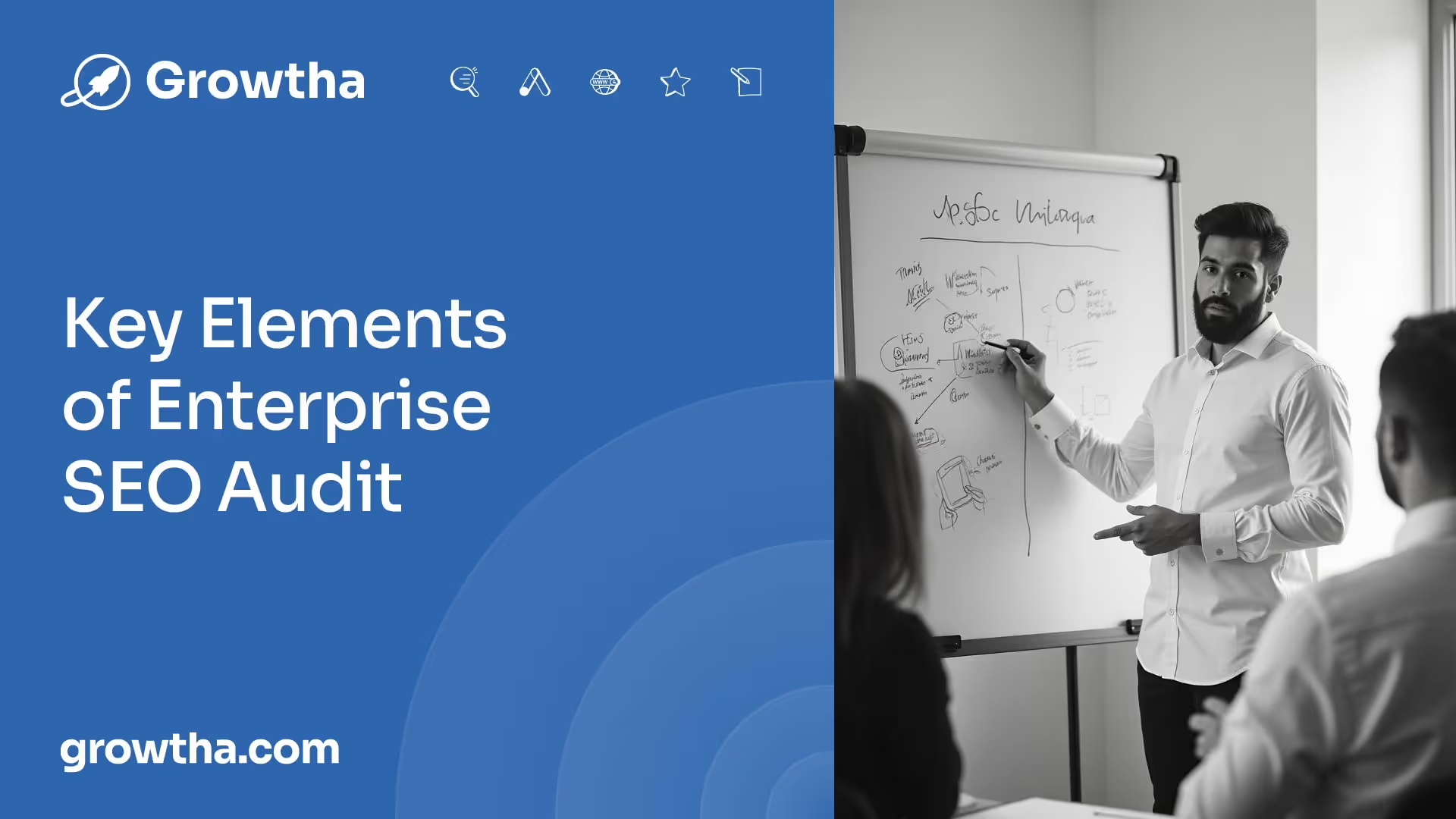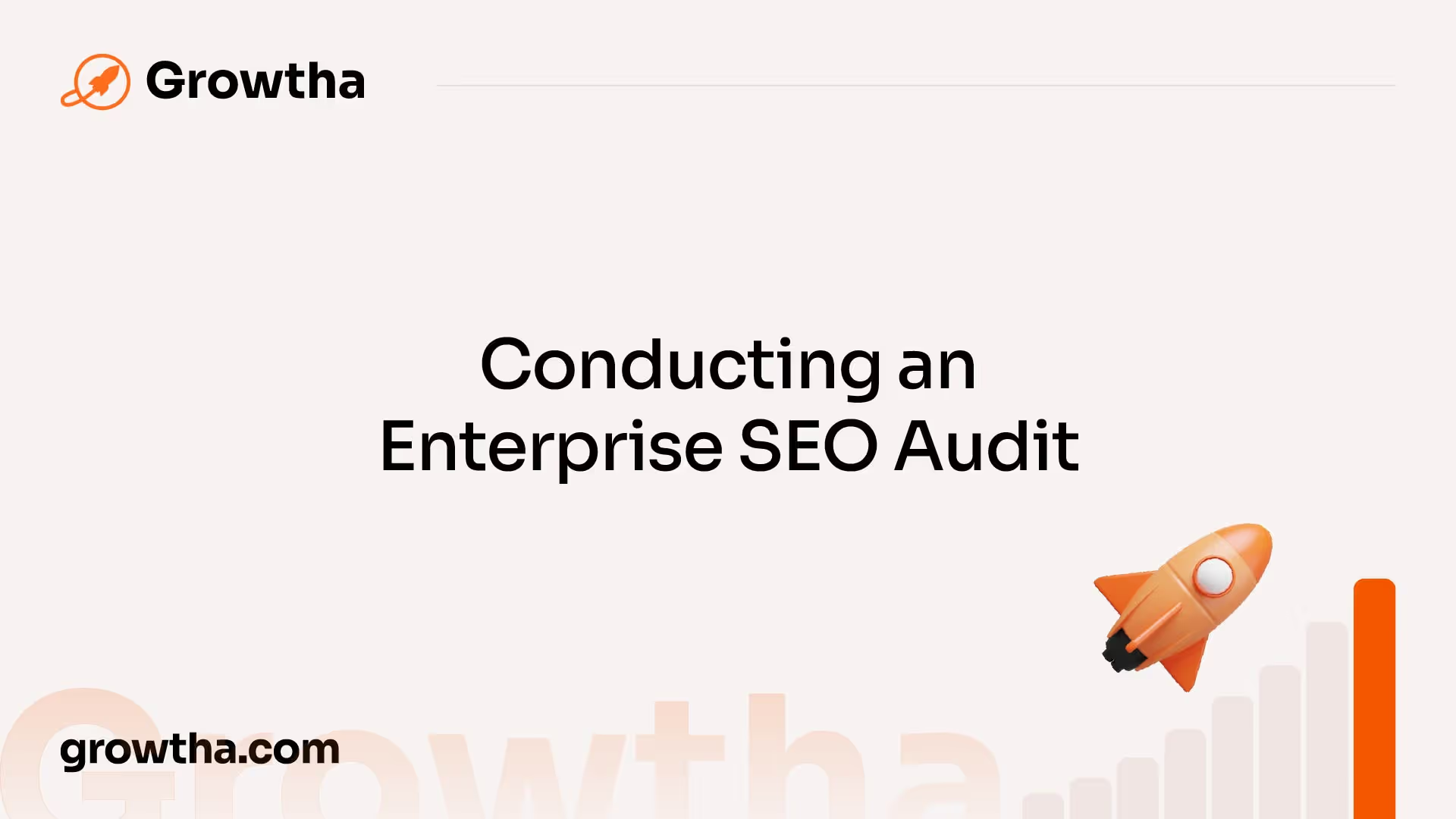What is an Enterprise SEO Audit & How To Do One
This process involves evaluating the website's optimization levels, identifying any errors or issues that may hinder its ranking, and uncovering opportunities for improvement.


What is an Enterprise SEO Audit & How To Do One

Understanding Enterprise SEO Audit
To optimize a website for search engines and improve its visibility, it is crucial to conduct an enterprise SEO audit. This process involves evaluating the website's optimization levels, identifying any errors or issues that may hinder its ranking, and uncovering opportunities for improvement. An SEO audit can be likened to a comprehensive "health check" for a website, ensuring it is in optimal condition for search engine performance [1].
Importance of SEO Audit
An SEO audit holds significant importance in the world of search engine optimization. By conducting an audit, businesses can gain valuable insights into the current state of their website's SEO, identify areas for enhancement, and develop a data-driven strategy to achieve better search engine rankings.
Some key benefits of an SEO audit include:
- Identifying Technical Issues: An audit allows businesses to uncover technical issues that may impact their website's performance, such as broken links, duplicate content, or slow page loading times. Addressing these issues can improve user experience and search engine crawling.
- Improving Website Visibility: By identifying and optimizing relevant keywords, analyzing competitors, and aligning website content with search intent, an audit helps improve a website's visibility on search engine result pages (SERPs). This can lead to increased organic traffic and potential customers.
- Enhancing User Experience: An SEO audit assesses the overall user experience on a website, considering factors such as ease of navigation, mobile-friendliness, and site speed. By improving these aspects, businesses can enhance user satisfaction and engagement, reducing bounce rates and increasing conversions.
Tools for SEO Audit
Performing a comprehensive SEO audit requires the use of specialized tools that provide valuable insights and data about a website's current state. Some essential tools for conducting an SEO audit include:
- Google Search Console: Google Search Console is a critical tool for SEO professionals. It provides valuable information about a website's performance, including statistics on clicks, impressions, position, and click-through rates. It also offers insights on Google algorithm updates and identifies site errors. Additionally, it tracks featured snippets and is free to use.
- Google Analytics: Google Analytics is a robust tool that tracks site performance data from various channels. It provides insights on user behavior, traffic sources, conversions, and other key metrics. This data helps businesses understand customer interactions, measure performance, and make data-driven decisions. Google Analytics is free to use and is an essential tool for understanding a website's performance [2].
- SEMrush: SEMrush is a comprehensive SEO tool that offers a range of features, including organic keyword research, competitor analysis, backlink audits, and traffic analytics. SEMrush's Site Audit tool specifically examines over 130 technical and SEO mistakes, providing recommendations to improve search rankings. It is a valuable tool for conducting a quick and easy technical audit of websites [3].
By utilizing these tools, businesses can gather essential data and insights to perform a detailed and effective enterprise SEO audit. These insights, in turn, help identify areas of improvement and implement strategies to enhance a website's search engine performance.
Key Elements of Enterprise SEO Audit

In order to optimize the performance of an enterprise website and improve its visibility in search engine results, conducting a comprehensive SEO audit is essential. This process involves assessing various key elements to identify areas for improvement. Three crucial elements of an enterprise SEO audit include the technical health assessment, mobile-friendliness evaluation, and page speed analysis.
Technical Health Assessment
For enterprise websites with thousands of pages and complex elements, such as product catalogs and franchise locations, ensuring a strong technical foundation is crucial. This assessment involves evaluating the website's technical infrastructure and identifying any issues that may hinder search engine crawling and indexing.
During the technical health assessment, factors such as website structure, URL structure, internal linking, and XML sitemap functionality are scrutinized. Additionally, it is important to analyze the correct implementation of canonical tags to avoid content duplication issues.
Mobile-Friendliness Evaluation

With over 60% of organic search traffic coming from mobile devices, optimizing a website for mobile search is crucial. Google now uses mobile-first indexing, considering the mobile version of a website as the primary source for ranking purposes. As a result, evaluating the mobile-friendliness of an enterprise website is vital during an SEO audit.
A mobile-friendliness evaluation includes assessing factors such as responsive design, mobile page load speed, and mobile user experience. It is important to ensure that the website is properly optimized for different mobile devices and screen sizes, providing a seamless browsing experience for mobile users.
Page Speed Analysis
Page speed is not only a critical user experience factor but also an important ranking factor [1]. Slow-loading pages can increase the chances of users leaving a website, leading to higher bounce rates. Therefore, analyzing a website's page speed and addressing any issues can result in improved site speed and rankings.
During the page speed analysis, factors like server response time, image optimization, caching, and code optimization are examined. By identifying and resolving any performance bottlenecks, website owners can enhance the overall user experience and boost their search engine rankings.
By thoroughly assessing the technical health, mobile-friendliness, and page speed of an enterprise website, SEO professionals can identify areas for improvement and implement strategies to enhance its visibility in search engine results. Regular audits are essential to ensure ongoing optimization and maintain a strong online presence.
Conducting an Enterprise SEO Audit

When performing an enterprise SEO audit, there are several key elements to consider. In this section, we will explore the importance of user experience analysis, content visibility check, and content strategy evaluation.
User Experience Analysis
Conducting a comprehensive user experience analysis is a crucial aspect of an enterprise SEO audit. This involves utilizing tools like Google Analytics' Behavior Flow to understand visitor actions, bounce rates, time spent on page, conversions, and exit pages. By analyzing these metrics, you can gain insights into how users interact with your website and identify areas for improvement.
The goal of the user experience analysis is to optimize the user journey and ensure a seamless and enjoyable experience for visitors. By identifying any pain points or areas where users may encounter difficulties, you can make data-driven decisions to enhance the overall user experience.
Content Visibility Check
Ensuring content visibility is another critical aspect of an enterprise SEO audit. It involves checking whether Google's bots regularly crawl and render your website. One way to check content visibility is by using the "site:yourURL.com" search command to view the cached version of your site. This helps ensure that your content is visible and up-to-date for search engines and visitors [6].
Regularly monitoring and optimizing content visibility is essential to maintain a strong online presence. By ensuring that search engines can access and index your content effectively, you increase the likelihood of your website appearing in relevant search results.
Content Strategy Evaluation
Analyzing the content strategy of an enterprise website is a crucial step in the SEO audit process. This involves assessing the performance of existing content, identifying any gaps or areas for improvement, and planning for future content development.
A robust content strategy should align with the brand's expertise, address the needs of the target audience, and elevate the brand's online presence. By evaluating the quality, relevance, and engagement of your content, you can identify opportunities to optimize existing content and create new content that drives organic traffic and supports your SEO goals.
Regularly refreshing and updating content is essential to keep it relevant, show search engines active maintenance, maintain high rankings, and enhance user engagement [6]. By continuously evaluating and improving your content strategy, you can ensure that your website provides valuable and informative content to your target audience.
Conducting a comprehensive user experience analysis, ensuring content visibility, and evaluating the content strategy are all vital components of an enterprise SEO audit. By focusing on these elements, you can optimize your website for better user experiences, improved search visibility, and enhanced content performance.
Enhancing Enterprise SEO

To maximize the effectiveness of an enterprise SEO strategy, it's crucial to continuously enhance and optimize various aspects of the website. In this section, we will explore two key areas for improvement: content refresh strategies and utilizing Google Search Console insights.
Content Refresh Strategies
Regularly refreshing and updating content on an enterprise website is essential to keep it relevant, show search engines active maintenance, maintain high rankings, and enhance user engagement. By implementing effective content refresh strategies, enterprises can breathe new life into their website and attract more organic traffic.
To effectively refresh content, start by analyzing the performance of existing content. Identify pages that are underperforming or have outdated information. By updating these pages with fresh and valuable content, you can improve their visibility and organic search rankings.
Another strategy is to create new content that addresses trending topics or emerging industry trends. Conduct thorough keyword research to identify relevant and high-performing keywords. By incorporating these keywords strategically into your new content, you can increase its visibility and attract targeted organic traffic.
It's important to note that content refresh strategies should also focus on improving user experience. Ensure that the content is easy to read, visually appealing, and well-structured. Incorporate visual elements such as images, infographics, and videos to enhance engagement and provide valuable information to your audience.
Google Search Console Insights
Google Search Console provides valuable insights into how your website performs in search engine results. Utilizing these insights can help enterprises identify areas for improvement and make data-driven decisions to enhance their SEO efforts.
One important aspect to monitor is content visibility. By checking Google's bots' regular crawling and rendering of the site, you can ensure that the content is visible and up-to-date. Use the "site:yourURL.com" search command to view the cached version of the site and ensure that the content is accessible to search engines and users [6].
Additionally, analyze the performance of your website using the Search Console's performance reports. Identify pages that receive high impressions but have low click-through rates. By optimizing meta tags, titles, and descriptions, you can improve the visibility and clickability of these pages, thereby driving more organic traffic.
Leverage the data provided by the Search Console to identify keywords that are driving the most traffic to your website. This information can help you refine your content strategy and create more targeted and relevant content that aligns with your audience's interests and needs.
By incorporating content refresh strategies and utilizing the valuable insights from Google Search Console, enterprises can enhance their SEO efforts, improve their organic search rankings, and attract more relevant organic traffic.
Challenges in Enterprise SEO Audit
Performing an enterprise SEO audit comes with its own set of challenges. These challenges can vary depending on the organization and its history. In this section, we will explore three common challenges that arise when conducting an enterprise SEO audit: organizational silos, historical neglect, and soft skills development.
Organizational Silos
One challenge often faced in enterprise SEO audits is the presence of organizational silos. In large organizations, different departments may have their own goals, priorities, and strategies, which can hinder the implementation of SEO recommendations. Getting budget approvals, securing cross-departmental support, or obtaining stakeholder sign-offs can take weeks or even months, slowing down the progress of SEO initiatives [7].
To overcome this challenge, it is crucial to foster effective communication and collaboration between departments. Breaking down silos and creating cross-functional teams can facilitate the implementation of SEO recommendations, ensuring that all relevant stakeholders are aligned and working towards a common goal.
Historical Neglect
Historical neglect is another common challenge in enterprise SEO audits. Over time, websites may have accumulated technical issues, outdated content, and suboptimal site structures. Addressing these historical issues requires a thorough SEO audit to identify and prioritize the core issues that will drive change and revenue.
By conducting a comprehensive audit, organizations can uncover areas of improvement and develop a roadmap for addressing historical neglect. Prioritization is key in this process, focusing on core issues that will have the most significant impact on organic visibility and user experience. Through strategic prioritization and execution, organizations can revitalize their SEO efforts and drive positive results.
Soft Skills Development
In enterprise SEO, soft skills play a crucial role alongside technical SEO skills. Digital leaders and SEO channel owners spend time reporting results, presenting insights to executives, and managing up. Effective communication and influence are vital in gaining support and resources for SEO initiatives within the organization [7].
Developing soft skills among SEO professionals is essential for successful enterprise SEO audits. This includes honing skills in presenting data-driven insights, building relationships with stakeholders, and effectively communicating the value and impact of SEO. By emphasizing the importance of soft skills, organizations can foster a culture that supports and recognizes the value of SEO within the enterprise.
Overcoming these challenges requires a structured approach, advanced tools, and experienced SEO professionals. By addressing organizational silos, historical neglect, and developing soft skills, organizations can navigate the complexities of an enterprise SEO audit and drive impactful changes that enhance visibility, user experience, and organic traffic [8].
Implementing SEO Recommendations
Once an enterprise SEO audit is complete, it is crucial to implement the identified recommendations to improve the website's search engine optimization. In this section, we will explore three key areas for implementation: technical SEO prioritization, meta tags optimization, and URL structure assessment.
Technical SEO Prioritization
Technical SEO plays a vital role in determining a website's crawlability, indexation, and search rankings. It involves updates to the website and server that impact various components such as page titles, title tags, HTTP header responses, XML sitemaps, 301 redirects, and metadata. Prioritizing technical SEO recommendations can significantly enhance a website's search visibility and overall SEO success.
Common technical SEO issues that need attention include:

Table based on information from seoClarity
By addressing these technical issues, a website can improve crawlability, indexation, and search rankings.
Meta Tags Optimization
Meta tags, including meta titles and meta descriptions, play a crucial role in how search engines index and display a webpage in search results. Optimizing meta tags involves crafting concise, relevant, and keyword-rich titles and descriptions to enhance search visibility and encourage user click-through rates.
Common meta tags optimization considerations include:
- Writing unique meta titles and descriptions for each webpage
- Including relevant keywords naturally within the meta tags
- Ensuring meta descriptions are compelling and encourage users to click
- Keeping meta titles within the recommended character limit (typically around 50-60 characters) for optimal display in search results
By optimizing meta tags, a website can improve its chances of appearing prominently in search engine results pages and attract more organic traffic.
URL Structure Assessment
The URL structure of a website plays a role in both user experience and search engine optimization. A well-structured URL provides clarity and helps search engines understand the content of a webpage. When assessing URL structure, consider the following:
- Ensuring URLs are descriptive and include relevant keywords
- Avoiding long and complex URLs that can be difficult for users and search engines to understand
- Using hyphens to separate words in the URL for readability
- Addressing any issues with multiple versions of the homepage (e.g., "yourwebsite.com" and "www.yourwebsite.com") to avoid confusion and ensure proper indexing
By optimizing the URL structure, a website can improve its search visibility and make it easier for users to navigate.
Implementing these SEO recommendations is a critical step in improving the overall search engine optimization of an enterprise website. By prioritizing technical SEO, optimizing meta tags, and assessing URL structure, a website can enhance its search visibility, user experience, and ultimately drive more organic traffic.
References
[1]: https://www.semrush.com/blog/seo-audit/
[2]: https://www.searchenginejournal.com/seo-audit/seo-audit-tools/
[3]: https://seodigitalgroup.com/best-seo-audit-tools/
[4]: https://searchengineland.com/what-your-enterprise-seo-audit-may-be-missing-432209
[5]: https://www.semrush.com/blog/enterprise-seo-audit/
[6]: https://www.firstpagestrategy.com/marketing-blog/enterprise-seo-audit
[7]: https://www.conductor.com/academy/enterprise-seo-challenges/
[8]: https://www.analyticodigital.com/blog/how-to-do-an-enterprise-seo-audit-key-components-to-check







